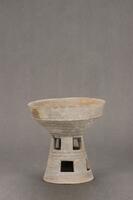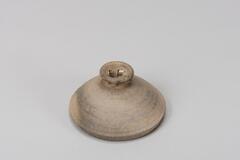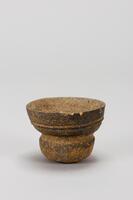101 UMMA Objects
101 UMMA Objects
![Large oblong, rectangular wooden bowl with rounded ends.<br />
<br />
These large bowls (<em>hamji</em>) were made by carving out large, single pieces of wood. Notches or handles have been carved out on two opposite sides of the outer walls, making them easy to carry. Round hamji bowls were sometimes carved on a turning lathe, but those with notches could be made by carving out single lengths of wood with an adz. These bowls were used in towns and the countryside alike. Affluent households would possess sets of large, medium-sized, and small bowls with notches piled up together. When grinding mung beans, beans, or red beans, such bowls are placed below a grindstone supported by a tripod.
<p>[Korean Collection, University of Michigan Museum of Art (2017) p. 274]</p>
Large oblong, rectangular wooden bowl with rounded ends.<br />
<br />
These large bowls (<em>hamji</em>) were made by carving out large, single pieces of wood. Notches or handles have been carved out on two opposite sides of the outer walls, making them easy to carry. Round hamji bowls were sometimes carved on a turning lathe, but those with notches could be made by carving out single lengths of wood with an adz. These bowls were used in towns and the countryside alike. Affluent households would possess sets of large, medium-sized, and small bowls with notches piled up together. When grinding mung beans, beans, or red beans, such bowls are placed below a grindstone supported by a tripod.
<p>[Korean Collection, University of Michigan Museum of Art (2017) p. 274]</p>](/media/W1siZiIsIjIwMjIvMDkvMjQvMmFtMWgzNXk0c19kZWZhdWx0LmpwZyJdLFsicCIsInRodW1iIiwiMjQweDIwMCJdXQ?sha=abbd1ecb4867c0dc)
Korean (Korean (culture or style))
Wooden Bowl
1850 – 1950
Gift of Ok Ja Chang and the Chang Family
2009/2.29
![Wooden table with a dodecagon table top and rounded out legs.<br />
<br />
This dog-legged tray-table has its name derived from the shape of its curved legs which resemble those of dogs. The table top and its raised brim are made from the same single piece of thick board. Aprons between the legs, immediately under the table top, are not shaped in identical proportion, as they were initially made long and were shortened where it was needed. Bamboo pegs are driven into the table top to join it with the aprons, and the stretchers are nailed to the legs by nails driven in from the bottom.
<p>[Korean Collection, University of Michigan Museum of Art (2017) p. 258]</p>
Wooden table with a dodecagon table top and rounded out legs.<br />
<br />
This dog-legged tray-table has its name derived from the shape of its curved legs which resemble those of dogs. The table top and its raised brim are made from the same single piece of thick board. Aprons between the legs, immediately under the table top, are not shaped in identical proportion, as they were initially made long and were shortened where it was needed. Bamboo pegs are driven into the table top to join it with the aprons, and the stretchers are nailed to the legs by nails driven in from the bottom.
<p>[Korean Collection, University of Michigan Museum of Art (2017) p. 258]</p>](/media/W1siZiIsIjIwMjIvMDkvMjQvNzRsNmlobWYwc19kZWZhdWx0LmpwZyJdLFsicCIsInRodW1iIiwiMjQweDIwMCJdXQ?sha=2edc8f3a2585cc9d)
Korean (Korean (culture or style))
Wooden Table
1850 – 1950
Gift of Ok Ja Chang and the Chang Family
2009/2.34
![A tall glazed and speckled white-blue porcelain offering dish for an altar. The base is a wide, slightly tapered cylinder. The dish a the top is quite wide and shallow until it reaches the point of the base, where there is a deep hole in the cylinder of the base.<br />
<br />
This is a hard-paste cup stand with a glossy surface. It is a high-grade object and was produced at a kiln in Bunwonri, Gwangju-si, Gyeonggi-do. There are fine cracks in one side of its foot.<br />
[Korean Collection, University of Michigan Museum of Art (2014) p.201] A tall glazed and speckled white-blue porcelain offering dish for an altar. The base is a wide, slightly tapered cylinder. The dish a the top is quite wide and shallow until it reaches the point of the base, where there is a deep hole in the cylinder of the base.<br />
<br />
This is a hard-paste cup stand with a glossy surface. It is a high-grade object and was produced at a kiln in Bunwonri, Gwangju-si, Gyeonggi-do. There are fine cracks in one side of its foot.<br />
[Korean Collection, University of Michigan Museum of Art (2014) p.201]](/media/W1siZiIsIjIwMjIvMDkvMjQvOG5lMHl3aGF4bl9kZWZhdWx0LmpwZyJdLFsicCIsInRodW1iIiwiMjQweDIwMCJdXQ?sha=db50cfeb2573abfa)
Korean (Korean (culture or style))
Altar Dish
1850 – 1899
Gift of Ok Ja Chang and the Chang Family
2009/2.43
![A glazed and speckled porcelain offering dish for an altar. The base is a wide decorated cylinder which tapers sharply into a narrow top. The base supports a wide, shallow bowl.<br />
<br />
This ritual dish was produced at a regional kiln. It is a low-quality object with a rough texture, made from the clay mixed with sand, contaminated with many impurities on the tray. Its glaze is dark with blue-green tints, giving the vessel the appearance of celadon. Its foot has an octagonal cross-section.<br />
[Korean Collection, University of Michigan Museum of Art (2014) p.200] A glazed and speckled porcelain offering dish for an altar. The base is a wide decorated cylinder which tapers sharply into a narrow top. The base supports a wide, shallow bowl.<br />
<br />
This ritual dish was produced at a regional kiln. It is a low-quality object with a rough texture, made from the clay mixed with sand, contaminated with many impurities on the tray. Its glaze is dark with blue-green tints, giving the vessel the appearance of celadon. Its foot has an octagonal cross-section.<br />
[Korean Collection, University of Michigan Museum of Art (2014) p.200]](/media/W1siZiIsIjIwMjIvMDkvMjQvNm45anZucHNldV9kZWZhdWx0LmpwZyJdLFsicCIsInRodW1iIiwiMjQweDIwMCJdXQ?sha=ccdbeadfd710d294)
Korean (Korean (culture or style))
Altar Dish
1850 – 1899
Gift of Ok Ja Chang and the Chang Family
2009/2.47
![A corn husk woven basket with wooden shaping dowels. One side of the rectangle is flat while the other end is curved. There are two blue stripes on the inside floor of the basket and green and purple designs on the outside.<br />
<br />
This straw basket (<em>samtaegi</em> ) is woven from dyed straw. The round frame at the back of it is made from bitterwood and the front part from bamboo. Judging from the use of dyed straw, this basket was probably used for drying grain such as soy beans.
<p>[Korean Collection, University of Michigan Museum of Art (2017) p. 277]</p>
A corn husk woven basket with wooden shaping dowels. One side of the rectangle is flat while the other end is curved. There are two blue stripes on the inside floor of the basket and green and purple designs on the outside.<br />
<br />
This straw basket (<em>samtaegi</em> ) is woven from dyed straw. The round frame at the back of it is made from bitterwood and the front part from bamboo. Judging from the use of dyed straw, this basket was probably used for drying grain such as soy beans.
<p>[Korean Collection, University of Michigan Museum of Art (2017) p. 277]</p>](/media/W1siZiIsIjIwMjIvMDkvMjQvZmVlMTZ2YW0yX2RlZmF1bHQuanBnIl0sWyJwIiwidGh1bWIiLCIyNDB4MjAwIl1d?sha=63e41f30e2d00ee4)
Korean (Korean (culture or style))
Winnowing Basket
1850 – 1950
Gift of Ok Ja Chang and the Chang Family
2009/2.49
![A rectangluar box woven with bamboo. There is a strip of bamboo with a clasp to keep the basket closed and in one piece. Used as a fermer's lunchbox.<br />
<br />
This lunchbox is woven from strips of bamboo. The outer part is plain-woven, while the inner part is woven in the style of a reed mat. The frame is made from bands of bamboo tied together in two places. Lunchboxes such as this one were used to deliver meals to those working in fields.
<p>[Korean Collection, University of Michigan Museum of Art (2017) p. 278]</p>
A rectangluar box woven with bamboo. There is a strip of bamboo with a clasp to keep the basket closed and in one piece. Used as a fermer's lunchbox.<br />
<br />
This lunchbox is woven from strips of bamboo. The outer part is plain-woven, while the inner part is woven in the style of a reed mat. The frame is made from bands of bamboo tied together in two places. Lunchboxes such as this one were used to deliver meals to those working in fields.
<p>[Korean Collection, University of Michigan Museum of Art (2017) p. 278]</p>](/media/W1siZiIsIjIwMjIvMDkvMjQvMW04NXo0anoyNl9kZWZhdWx0LmpwZyJdLFsicCIsInRodW1iIiwiMjQweDIwMCJdXQ?sha=39da02e99668303f)
Korean (Korean (culture or style))
Farmer's Lunchbox
1850 – 1950
Gift of Ok Ja Chang and the Chang Family
2009/2.50
![A wide cylindrically-shaped basket with an opening at the top. Used to store seeds while farmers would walk and scatter them to plant.<br />
<br />
This seed pouch is made by weaving double strips of Korean moonseed, following the method of weaving a straw mat. It was used to store seeds or when plating them.
<p>[Korean Collection, University of Michigan Museum of Art (2017) p. 277]</p>
A wide cylindrically-shaped basket with an opening at the top. Used to store seeds while farmers would walk and scatter them to plant.<br />
<br />
This seed pouch is made by weaving double strips of Korean moonseed, following the method of weaving a straw mat. It was used to store seeds or when plating them.
<p>[Korean Collection, University of Michigan Museum of Art (2017) p. 277]</p>](/media/W1siZiIsIjIwMjIvMDkvMjQvNGtqOG4ycmlsMV9kZWZhdWx0LmpwZyJdLFsicCIsInRodW1iIiwiMjQweDIwMCJdXQ?sha=df082d9928744ecc)
Korean (Korean (culture or style))
Seed Planting Basket
1850 – 1950
Gift of Ok Ja Chang and the Chang Family
2009/2.54

Korean (Korean (culture or style))
Bowl with Stand
400 – 599
Gift of Ok Ja Chang and the Chang Family
2009/2.70

Korean (Korean (culture or style))
Lid for Bowl
400 – 599
Gift of Ok Ja Chang and the Chang Family
2009/2.77

Korean (Korean (culture or style))
Bowl
400 – 599
Gift of Ok Ja Chang and the Chang Family
2009/2.78
![A large rectangular brass-colored metal bar lock, similar to a u-bar lock, meant to use as a lock for a chest.<br />
<br />
This pipe-shaped lock is made of nickel. The key has been lost. The protruding part at the left end is decorated with six incised rings/
<p>[Korean Collection, University of Michigan Museum of Art (2017), 246]</p>
A large rectangular brass-colored metal bar lock, similar to a u-bar lock, meant to use as a lock for a chest.<br />
<br />
This pipe-shaped lock is made of nickel. The key has been lost. The protruding part at the left end is decorated with six incised rings/
<p>[Korean Collection, University of Michigan Museum of Art (2017), 246]</p>](/media/W1siZiIsIjIwMjIvMDkvMjQvMzFsOHI1eTE1cl9kZWZhdWx0LmpwZyJdLFsicCIsInRodW1iIiwiMjQweDIwMCJdXQ?sha=d4e1d7e5d6bbfa83)
Korean (Korean (culture or style))
Lock for Chest
1850 – 1950
Gift of Ok Ja Chang and the Chang Family
2009/2.59
![A large rectangular metal bar lock, similar to a u-bar lock fitted with a key made up of two metal strips in the shape of a wedge, meant to use as a lock for a chest.<br />
<br />
Pipe-shaped locks such as these were used for locking boxes and chests. Their keys have been lost. Each of their bodies was made by forging two plates before soldering them together.
<p>[Korean Collection, University of Michigan Museum of Art (2017), 246]</p>
A large rectangular metal bar lock, similar to a u-bar lock fitted with a key made up of two metal strips in the shape of a wedge, meant to use as a lock for a chest.<br />
<br />
Pipe-shaped locks such as these were used for locking boxes and chests. Their keys have been lost. Each of their bodies was made by forging two plates before soldering them together.
<p>[Korean Collection, University of Michigan Museum of Art (2017), 246]</p>](/media/W1siZiIsIjIwMjIvMDkvMjQvNnkxMm5vZWlycF9kZWZhdWx0LmpwZyJdLFsicCIsInRodW1iIiwiMjQweDIwMCJdXQ?sha=373b5cc80a6ccfc3)
Korean (Korean (culture or style))
Lock for Chest
1850 – 1950
Gift of Ok Ja Chang and the Chang Family
2009/2.61
Loading…
